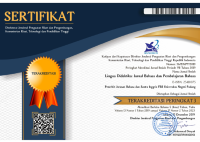The Implementation of Blended Synchronous and Asynchronous Online Language Learning during the Covid-19 Pandemic
 ),
), (1) Universitas Nahdlatul Ulama Yogyakarta
 Corresponding Author
Corresponding Author
Copyright (c) 2022 Lingua Didaktika: Jurnal Bahasa dan Pembelajaran Bahasa
DOI : https://doi.org/10.24036/ld.v16i1.114328
Full Text:
 Language : en
Language : en
Abstract
The Covid-19 Pandemic has disrupted interaction and communication between teachers and students in teaching and learning. Hence, online learning becomes recourse to reach students’ presence. Both are separated into divergent space and time. However, in practice, students get inconvenience in apprehending and receiving knowledge on screen given by teachers. Accordingly, certain manners have been led to solve and to simplify remote teaching by combining both synchronous and asynchronous learning modes. This study aimed to explore, to investigate, and to describe students’ perceptions and learning practices at implementation of online language learning using blended synchronous and asynchronous communication. Data obtained was from the observation, the interview, the students’ questionnaire derived from the Google Form, and the need analysis in the preliminary study toward higher students of Nahdlatul Ulama University of Yogyakarta majoring English Education Department. It was a case study research design. The descriptive and quantitative analysis was used to describe and to interpret the obtained data from respondents. The results showed that the students were more enthusiastic with the combination between synchronous and asynchronous learning modes than videoconference only. Furthermore, evidences represented the students were motivated with asynchronous tools such as WhatsApp, Google Docs, and Google Classroom with the reasons: easy to reach communication, cheap in costs, multifunction, and fast in responses. In acquiring clear interaction and a direct meeting, the live conference like Zoom and Google Meet became the right preferences for both teachers and the students.
Keywords
References
Ahmed, S. T. S. (2019). WhatsApp and learn English: a study of the effectiveness of WhatsApp in developing reading and writing skills in English. ELS Journal on Interdisciplinary Studies on Humanities, 2(2), 148–156.
Cooper, K., & E.White, R. (2012). Qualitative Research in the Post-Modern Era: Contexts of Qualitative Research. New York: Springer.
Dahlstrom-Hakki, I., Alstad, Z., & Banerjee, M. (2020). Comparing synchronous and asynchronous online discussions for students with disabilities: The impact of social presence. Computers and Education, 150, 1–11. https://doi.org/10.1016/j.compedu.2020.103842
deNoyelles, A, Zydney, J. & Chen, B. (2014). Strategies for creating a community of inquiry through online asynchronous discussions. Journal of Online Learning and Teaching, 10(1), 153–165.
Favale, T., Soro, F., Trevisan, M., Drago, I., & Mellia, M. (2020). Campus traffic and e-learning during COVID-19 pandemic. Computer Networks, 176, 1–9. https://doi.org/10.1016/j.comnet.2020.107290
George, M. L. (2020). Effective teaching and examination strategies for undergraduate learning during COVID-19 school restrictions. Journal of Educational Technology Systems, 49(1), 23–48. https://doi.org/10.1177/0047239520934017
Grogan, D. (2015). Disentangling the threads: analysing synchronous online discussions. Creative Education, 06(03), 338–349. https://doi.org/10.4236/ce.2015.63032
Heilporn, G., Lakhal, S., & Bélisle, M. (2021). An examination of teachers’ strategies to foster student engagement in blended learning in higher education. International Journal of Educational Technology in Higher Education, 18(25), 1–25. https://doi.org/10.1186/s41239-021-00260-3
Hung, M. L., Chou, C., Chen, C. H., & Own, Z. Y. (2010). Learner readiness for online learning: scale development and student perceptions. Computers and Education, 55(3), 1080–1090. https://doi.org/10.1016/j.compedu.2010.05.004
Kholis, A. (2020). The use of WhatsApp app in distance language learning in pandemic Covid-19: a case study in Nahdlatul Ulama University of Yogyakarta. LET: Linguistics, Literature, and English Teaching Journal, 10(2), 24–43. https://doi.org/10.18592/let.v10i2.4051
L.Berg, B. (2001). Qualitative Research Methods for the Social Sciences (4th ed.). London: Allyn and Bacon. https://doi.org/10.1177/1049909106294983
McBrien, J. L., Jones, P., & Cheng, R. (2009). Virtual spaces: employing a synchronous online classroom to facilitate student engagement in online learning. International Review of Research in Open and Distance Learning, 10(3), 1–17. https://doi.org/10.19173/irrodl.v10i3.605
Murphy, E., Rodríguez-Manzanares, M. A., & Barbour, M. (2011). Asynchronous and synchronous online teaching: Perspectives of Canadian high school distance education teachers. British Journal of Educational Technology, 42(4), 583–591. https://doi.org/10.1111/j.1467-8535.2010.01112.x
Muthuprasad, T., Aiswarya, S., Aditya, K. S., & Jha, G. K. (2021). Students’ perception and preference for online education in India during COVID -19 pandemic. Social Sciences & Humanities Open, 3(1), 1–11. https://doi.org/10.1016/j.ssaho.2020.100101
Negash, S., Whitman, M. E., Woszczynski, A. B., Hoganson, K., & Mattord, H. (2008). Handbook of distance learning for real-time and asynchronous information technology education. New York: Information Science Reference. https://doi.org/10.4018/978-1-59904-964-9
Perveen, A. (2016). Synchronous and asynchronous e-language learning: a case study of virtual University of Pakistan. Open Praxis, 8(1), 21–39. https://doi.org/10.5944/openpraxis.8.1.212
Pineda Hoyos, J. E. (2018). Error correction and repair moves in synchronous learning activities. International Journal of Educational Technology in Higher Education, 15(23), 1–17. https://doi.org/10.1186/s41239-018-0105-2
Rehn, N., Maor, D., & McConney, A. (2016). Investigating teacher presence in courses using synchronous videoconferencing. Distance Education, 37(3), 1–16. https://doi.org/10.1080/01587919.2016.1232157
Shamsudin, H., Hashim, H., & Yunus, M. M. (2019). Integration of asynchronous and synchronous gameplay to improve pupils’ vocabulary. Creative Education, 10(12), 3101–3106. https://doi.org/10.4236/ce.2019.1012234
Shintani, N. (2015). The effects of computer-mediated synchronous and asynchronous direct corrective feedback on writing: a case study. Computer Assisted Language Learning, 29(3), 1–24. https://doi.org/10.1080/09588221.2014.993400
 Article Metrics
Article Metrics
 Abstract Views : 460 times
Abstract Views : 460 times
 PDF Downloaded : 131 times
PDF Downloaded : 131 times
Refbacks
- There are currently no refbacks.
Copyright (c) 2022 Lingua Didaktika: Jurnal Bahasa dan Pembelajaran Bahasa

This work is licensed under a Creative Commons Attribution-NonCommercial 4.0 International License.









